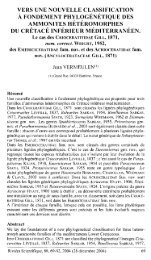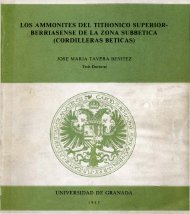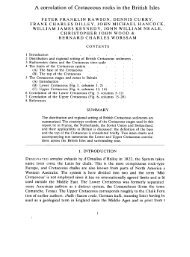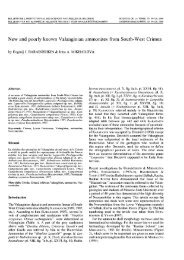thiolliericrinid crinoids from the lower cretaceous of crimea
thiolliericrinid crinoids from the lower cretaceous of crimea
thiolliericrinid crinoids from the lower cretaceous of crimea
Create successful ePaper yourself
Turn your PDF publications into a flip-book with our unique Google optimized e-Paper software.
— 639 —Thiolliericrinus t orosus nov. sp.D e r iv a t io n o m i n i s :figs. 4 D ; 6 B-EThe name <strong>of</strong> <strong>the</strong> species comes <strong>from</strong> « torosus »(pustulous in Latin).H o l o t y p e :CK-86-1 (fig. 6 B) ; Leningrad Mining Institute.Ty p e l o c a l it y :Kuibyshevo, Belbek Valley, Crimea.Ty p e l e v e l :Upper Berriasian.T y p e l e v e l :Upper Berriasian.D e s c r i p t i o n :The calyx is low, conical, abruptly narrowed downwardswith <strong>the</strong> rounded-pentangular outline. Thebasais are visible on <strong>the</strong> calyx surface as small convextriangular plates. The external radial surface is verylow, overlapping <strong>the</strong> centrodorsal, and covered withbig irregular knobs. The calyx cavity is broad andshallow. 10 furrows go between <strong>the</strong> radiais and arefully pronounced on <strong>the</strong>ir middle part. The innerradial surface is slightly striated. The basais are notvisible on <strong>the</strong> bottom <strong>of</strong> <strong>the</strong> calyx cavity. The primaxillaryhas a muscular <strong>lower</strong> surface. Its externalsurface is tumid, cone-likely and covered with bigknobs. The height <strong>of</strong> <strong>the</strong> centrodorsal is about equalto <strong>the</strong> radial height, but <strong>the</strong> diameter <strong>of</strong> <strong>the</strong> centrodorsalis notably smaller than that <strong>of</strong> <strong>the</strong> radial ring.Three cirrus sockets are placed close to each o<strong>the</strong>runder each radial. Two large sockets are situated nearerto <strong>the</strong> radial and a small one is placed below, between<strong>the</strong> large ones. 15 sockets in all. The <strong>lower</strong> centrodorsalface is convex, ovate = oblong and has afulcral ridge with two narrow interrupted depressionson both sides, surrounded by a weak marginal ridge.D im e n s io n s :Ht = 7.2 mm ; Dt = 10.8 mm ; Dc = 6.0 mm ; A f= 57° ; Hr : H t = 0.07 - 0.11 ; Bf : Lf = 0.44 - 0.55.Co m p a r is o n :The centrodorsal <strong>of</strong> T. torosus is similar to that <strong>of</strong>T. arzierensis but has a considerably greater number<strong>of</strong> <strong>the</strong> cirrus sockets (15 againts 6-8) being placedregularly.M a t e r i a l s :2 calyxes, 1 centrodorsal, 2 radiais, 5 brachials, 4 cirrals(see table 1).D i s t r i b u t i o n :Berriasian ; Crimea.Genus Burdigalocrinus Ja e k e l , 19181918 — Burdigalocrinus : Ja e k e l , p.71.1924 — Burdigalocrinus Ja e k e l : Gislén, p. 188.1933 — Burdigalocrinus Ja e k e l : Dacqué, p. 103.1953 — Burdigalocrinus Ja e k e l : Sieverts-Doreck(in Ubaghs), p. 758.1961 — Burdigalocrinus Ja e k e l : Rasmussen, p.213.1978a —Burdigalocrinus Ja e k e l : Roux, p. 234.1978b —Burdigalocrinus Ja e k e l : Roux, p. A 20.1978c —Burdigalocrinus Ja e k e l : Rasmussen, p.880.T y p e s p e c ie s :Burdigalocrinus lorioli Ja e k e l , 1918.D i a g n o s i s :The radiais have high free external surface. Thebasais are visible on <strong>the</strong> calyx surface. Cirrus socketsare absent but <strong>the</strong>re are structureless fossae placed, asa rule, regularly. The centrodorsal is high and conical.The stem facet is wide, elliptical and flat.Two species : B. lorioli Ja e k e l , B. maximus nov.sp.Upper Jurassic (Oxfordian) - Lower Cretaceous(Berriasian) ; Portugal, Crimea.Burdigalocrinus lorioli Ja e k e l , 1918 (p. 72, fig. 64D,E) (= Thiolliericrinus ribeiroi D e L o r i o l , 1891, p.165 ex parte, pi. 29, fig. 17, non fig. 16, 18-22 =Thiolliericrinus ribeiroi) (Burdigalocrinus lorioli :Gislén 1924, p. 190 ; Rasmussen 1961, p. 213 ; 1978c,p. 881, fig. 588-4 ; Roux 1978b, p. A 20). Lusitanian ;Engenheiro (Ribatejo), Portugal (fig. 7 A).Burdigalocrinus maximus nov. sp.fig. 7 B,C ; pl. 1, fig. 1-3D e r iv a t io n o m i n i s :The name <strong>of</strong> <strong>the</strong> species comes <strong>from</strong> « maximus »(large in Latin).H o l o t y p e :CK-78-1 (fig. 7 B) ; Leningrad Mining Institute.
















